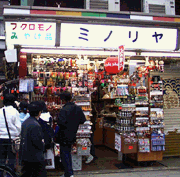| Asakusa Shrine (Sanja-sama) |
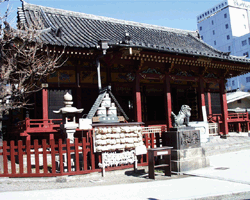 Known to the locals as Sanja-sama, Asakusa Shrine is located on the east side of Senso-ji Temple’s main building and is dedicated to Ebisu, one of the Seven Gods of Good Luck. The Asakusa Shrine festival, the Sanja Matsuri, is one of three major festivals that take place in Asakusa. Enshrined here are three men ? the Hinokuma Brothers and Hajino Nakatomo, from which the name Sanja(three gods)originated. A crest on the wall of a building where portable shrines are stored depicts three nets being cast, signifying that the chief priests of this shrine have been the descendents of the HInokuma Brothers. Built in 1649 by Tokugawa Iemitsu, the third shogun of the Tokugawa era, it has survived a number of fires over its 360-year history. It is designated a National Important Cultural Property by the Japanese government, and its gongen-style architecture takes you back to old Edo. You will also find Aoino-gomon, the Tokugawa crest, on the shrine. Many people visit Asakusa Shrine to see the kappore dance(a popular dance from the Edo Period) and monkey shows that are put on for their enjoyment. Visitors who come on holidays during the spring and fall are also welcome to enjoy a special cup of tea prepared in a traditional tea ceremony and served by geisha. Traditional Shinto-style wedding ceremonies held in the solemn atmosphere of this cultural heritage have become increasingly popular of late. The sight of beautiful kimono-clad brides in rickshaws en route to Asakusa Shrine is another part of Asakusa’s charm. Known to the locals as Sanja-sama, Asakusa Shrine is located on the east side of Senso-ji Temple’s main building and is dedicated to Ebisu, one of the Seven Gods of Good Luck. The Asakusa Shrine festival, the Sanja Matsuri, is one of three major festivals that take place in Asakusa. Enshrined here are three men ? the Hinokuma Brothers and Hajino Nakatomo, from which the name Sanja(three gods)originated. A crest on the wall of a building where portable shrines are stored depicts three nets being cast, signifying that the chief priests of this shrine have been the descendents of the HInokuma Brothers. Built in 1649 by Tokugawa Iemitsu, the third shogun of the Tokugawa era, it has survived a number of fires over its 360-year history. It is designated a National Important Cultural Property by the Japanese government, and its gongen-style architecture takes you back to old Edo. You will also find Aoino-gomon, the Tokugawa crest, on the shrine. Many people visit Asakusa Shrine to see the kappore dance(a popular dance from the Edo Period) and monkey shows that are put on for their enjoyment. Visitors who come on holidays during the spring and fall are also welcome to enjoy a special cup of tea prepared in a traditional tea ceremony and served by geisha. Traditional Shinto-style wedding ceremonies held in the solemn atmosphere of this cultural heritage have become increasingly popular of late. The sight of beautiful kimono-clad brides in rickshaws en route to Asakusa Shrine is another part of Asakusa’s charm.
→Click here for more details! |
| Senso-ji Temple |
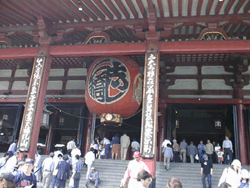 Senso-ji is the oldest temple in Tokyo and the seat of the Seikannon Sect, which carries the official name of Kinryuzan. Senso-ji is dedicated to Daikokuten, another of the Seven Gods of Good Luck. According to a legend, the history of this temple goes back 1,400 years to March 18, 628 AD, when two fishermen, the Hinokuma Brothers, found a statue of Buddha asuring about 5.5 cm in their fishing net as they pulled it out of the Etoura(now Sumida)River, and Hajino Nakatomo, the chief of their village, built a humble hut to enshrine the statue, became a priest and began worshipping the statue together with the two brothers who had found it. A kannon-do was built in its present location in the Heian Period by Kassai-Shonin, who opened it in the first year of Taika(645 AD). Since that time to this very day, the statue has not once been shown to the public. This temple is said to be the place where Tokugawa Ieyasu offered prayers before departing for the battle of Sekigahara to win control of the entire country. In 1649, after it was designated the official prayer hall of Tokugawa Ieyasu(deitified and named Tosho-Daigongen after his death), the third Tokugawa shogun, Iemitsu, had the temple building built. Later, following the relocation of the prayer hall to Ueno Kanei-ji Temple, it was cherished as a major religious site by the commoners. Senso-ji is the oldest temple in Tokyo and the seat of the Seikannon Sect, which carries the official name of Kinryuzan. Senso-ji is dedicated to Daikokuten, another of the Seven Gods of Good Luck. According to a legend, the history of this temple goes back 1,400 years to March 18, 628 AD, when two fishermen, the Hinokuma Brothers, found a statue of Buddha asuring about 5.5 cm in their fishing net as they pulled it out of the Etoura(now Sumida)River, and Hajino Nakatomo, the chief of their village, built a humble hut to enshrine the statue, became a priest and began worshipping the statue together with the two brothers who had found it. A kannon-do was built in its present location in the Heian Period by Kassai-Shonin, who opened it in the first year of Taika(645 AD). Since that time to this very day, the statue has not once been shown to the public. This temple is said to be the place where Tokugawa Ieyasu offered prayers before departing for the battle of Sekigahara to win control of the entire country. In 1649, after it was designated the official prayer hall of Tokugawa Ieyasu(deitified and named Tosho-Daigongen after his death), the third Tokugawa shogun, Iemitsu, had the temple building built. Later, following the relocation of the prayer hall to Ueno Kanei-ji Temple, it was cherished as a major religious site by the commoners.
The towns surrounding Senso-ji flourished, which contributed greatly to the development of Asakusa. Even today, there are still quite a few people who never forget to bow when passing by the temple, which is affectionately called “Kannon-sama” by the locals. After the original kannon-do (built in 649 AD and designated a national treasure) was burnt down during WWII, a makeshift shrine (currently known as Awashima-do) was built. It was rebuilt in 1958 with donations from worshippers.
Built in the Iriomoya style on a reinforced concrete foundation, it has a massive, steep roof covered with 72,000 roof tiles. This is, needless to say, one of the most popular tourist destinations in Japan.
→Click here for more details! |
| Kaminarimon |
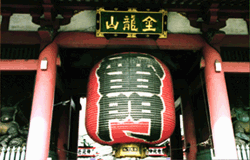 Situated in front of Senso-ji Temple, the Kaminarimon gate, officially known as the Fu-raijin-mon, has a huge 3.4-meter wide paper lantern weighing 670 kg that hangs from it. Situated in front of Senso-ji Temple, the Kaminarimon gate, officially known as the Fu-raijin-mon, has a huge 3.4-meter wide paper lantern weighing 670 kg that hangs from it.
You will be greeted by statues of fujin (the god of wind - on the right) and raijin (the god of thunder - on the left) enshrined on either side of the gate.In the olden days, they were worshipped by people wishing for stable weather and a bountiful harvest.
The gate often appears in the paintings of Hiroshige Ando, a famous Ukiyoe painter of the era. Since the Kamakura period, it has burnt down in fires and rebuilt a number of times. Long mocked as the “non-existing gate” after it was destroyed in the Great Edo Fire (1865), it was finally rebuilt in 1960 after 100 years.
The eight-pillared kiritsuma-style, tile-roof gate has a plate on the wall on which the temple’s official name “Kinryuzan” is written and a huge paper lantern hanging from it, both of which have become symbols of Asakusa. The only time the lantern is folded up is during the Sanja Matsuri festival when the portable shrines are carried in and out of the temple through this gate.
During the New Year holidays, the lantern is folded partially to make it easier for worshippers to pass through. The golden clasp at the bottom of the lantern bears the company’s name of Matsushita Electric Industrial Co. Few people know that the gate and lantern were donated by Konosuke Matsushita, former president of Matsushita, whose long-term knee problem disappeared after he prayed for recovery at the temple.
|
| Nitenmon (designated as a National Important Cultural Property) |
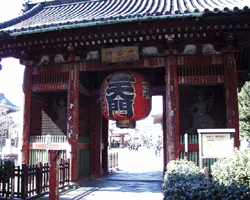 Built in 1618, Nitenmon has survived several wars. Its gate and stone bridge are designated as Important Cultural Properties. Originally used as the gate leading to Toshogu, where Tokugawa Ieyasu was enshrined, it was burnt down in a fire and later rebuilt in the present location. Built in 1618, Nitenmon has survived several wars. Its gate and stone bridge are designated as Important Cultural Properties. Originally used as the gate leading to Toshogu, where Tokugawa Ieyasu was enshrined, it was burnt down in a fire and later rebuilt in the present location.
On either side of the eight-pillared kiritsuma-style architecture, stand two deity guardians Jikokuten and Zochoten. They were brought to Nitenmon from Ueno Kanei-ji Temple, and are the reason this gate was renamed from Zuishinmon to Nitenmon (gate of two deities).
During the Edo period, it was used as the east entrance to Senso-ji for people who came across the Sumida River by ferry boat, and now it is used as an exit for worshippers during the New Year holidays.
You may wonder why there is a fire station right in front of the gate. Who knows? Perhaps it’s there to protect the gate from fire...
|
| Rokku Broadway |
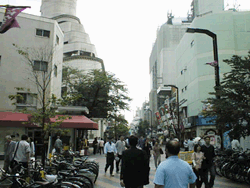 A paddy field that the priests at Senso-ji had put in to prevent fire from reaching the temple was drained in 1883 and turned into an entertainment district. A pond created during the redemption work was named Hyotan-ike because its shape resembled a hyotan, or gourd (although there had already been two ponds with this name long before this, one near Hanayashiki amusement park and the other near the Sumida River). A paddy field that the priests at Senso-ji had put in to prevent fire from reaching the temple was drained in 1883 and turned into an entertainment district. A pond created during the redemption work was named Hyotan-ike because its shape resembled a hyotan, or gourd (although there had already been two ponds with this name long before this, one near Hanayashiki amusement park and the other near the Sumida River).
The pond was reclaimed in 1951 and an entertainment facility “Shinsekai” was built where the pond once was. Currently, horse-racing betting booths stand here among the crowds of people that visit the area.
In 1884, an area called Asakusa-koen, which included Senso-ji Temple, was zoned into six different areas. The name Rokku comes from the time when this area was called Rokku (district six or the six areas). It was rezoned in 1951.
This was also an area where there were many street performances, show tents and theaters were to be found, and where famous comedians such as Enoken started their careers.
Asakusa streets were lined with kinetograph studios in the days of silent movies, and visitors could see all kinds of popular shows, from the Asakusa Opera, Asakusa revues such as SKD, to cloak-and-dagger dramas by a company led by Mitsuyo Asaka, and even strip shows.
The Ryounkaku building, also known as the Asakusa Junikai, located in Senzoku-machi was the first building in Japan to have an elevator (though it often broke down!).
After the building collapsed in the Great Kanto Earthquake, a Jintan breath mint advertising tower resembling the Ryounkaku building was erected at the intersection of Kokusai-dori and Kaminarimon-dori. It was however taken down around 1975.
This explains why so many people and writings confuse the building and the tower, believing that they were one and the same.
|
| Matsuchiyama-Shoten |
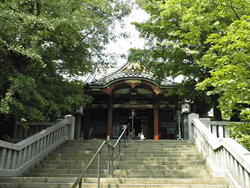 Matsuchiyama is a small hill on the west side of the Sumida River to the south of Imado-bashi Bridge. With the official name of Honryuin, Matsuchiyama-Shoten is a sub temple of Senso-ji, known as Shoten-sama by the locals. Matsuchiyama is a small hill on the west side of the Sumida River to the south of Imado-bashi Bridge. With the official name of Honryuin, Matsuchiyama-Shoten is a sub temple of Senso-ji, known as Shoten-sama by the locals.
Matsuchiyama is dedicated to Bishamonten, one of the Seven Gods of Good Luck.
Matsuchiyama has a history as old as Senso-ji, and a statue of the elephant-headed Kangiten Soshin, the god of family unity and flourishing business, is enshrined here. The statue is, however, not open to the public. Even more unique is the daikon-radish and pouch motif, representing the symbols of this temple, you will find on the front of the main.
Good luck monkey ornaments are available for ¥1,000, and daikon-radish is sold as offerings.
Admission free
|
| Asakusa Entertainment Hall (Engei-Hall) |
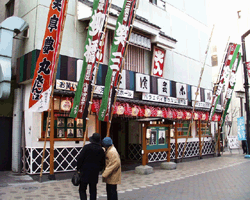 The Asakusa Entertainment Hall is a playhouse that was known as the Toyo Gekijo (theater) until was reopened in 1964 under the current name. It has given many entertainers the chance to cut their teeth on its stage. The Asakusa Entertainment Hall is a playhouse that was known as the Toyo Gekijo (theater) until was reopened in 1964 under the current name. It has given many entertainers the chance to cut their teeth on its stage.
With 340 seats (free seating), including balcony seats, spectators can enjoy rakugo (classical comedy), manzai (comic routines) and magic shows, one right after the other, from close-up.
The Akasaka Entertainment Hall offers daytime shows (11:40 - 16:30) and evening shows(16:40 - 21:00).
With no turnaround between acts, you get to laugh all day long!
Try once and you love this place!
(HP)http://www.asakusaengei.com/ |
| Toyokan |
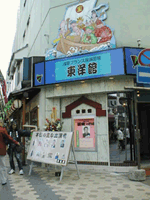 Formerly known as the Asakusa Fransu-za, it was located on the fourth floor of the Asakusa Entertainment Hall and is a place where many stars, such as world famous filmmaker Takeshi Kitano, a.k.a. Beat Takeshi, performed before they reached stardom. Formerly known as the Asakusa Fransu-za, it was located on the fourth floor of the Asakusa Entertainment Hall and is a place where many stars, such as world famous filmmaker Takeshi Kitano, a.k.a. Beat Takeshi, performed before they reached stardom.
It was turned into a multi-purpose hall in January of 2000, offering manzai(comic routines), mandan (stand-up comedy) and more during the day, and serving as a venue for various occasions and events. This place is the only variety acts a yose theater in all Tokyo.
|
| Asahi Head Office Building |
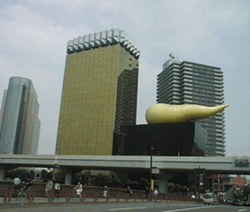 Since its completion in 1989,the Asahi Head Office Building has become known as a symbol of Asakusa. Although the building itself is not open to the public, it has some nice restaurants on the 21st and 22nd floors that offer a splendid view of the Sumida River. Since its completion in 1989,the Asahi Head Office Building has become known as a symbol of Asakusa. Although the building itself is not open to the public, it has some nice restaurants on the 21st and 22nd floors that offer a splendid view of the Sumida River.
The building neighbor on the right is Asahi Super Dry Hall(Azumabashi), as a motif sacred-fire.
|
| Asakusa Civic Auditorium |
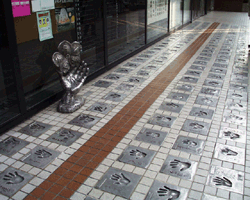 Built in the fall of 1977 with seating for 1,100, this auditorium offers a wide variety of shows and events. From the third floor, you can enjoy a view of the garden at Denpoin. On the stage equipped with a Hanamichi, a runway extending from the stage, Hanagata-kabuki (all-star kabuki) shows are performed. In the Stars Plaza, you can see the handprints of over 260 famous performers - Just like Hollywood, eh? Built in the fall of 1977 with seating for 1,100, this auditorium offers a wide variety of shows and events. From the third floor, you can enjoy a view of the garden at Denpoin. On the stage equipped with a Hanamichi, a runway extending from the stage, Hanagata-kabuki (all-star kabuki) shows are performed. In the Stars Plaza, you can see the handprints of over 260 famous performers - Just like Hollywood, eh?
When one of the performers whose handprint is displayed here has passed away, flowers are dedicated at the spot within the day.
|
| Mokuba-tei / Mokuba-kan |
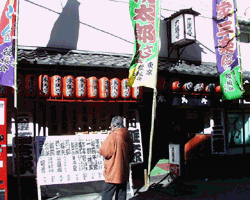 Open since 1928, this entertainment hall used to have an amusement space with a merry-go-round and other attractions on the first floor, and a stage offering magic and rokyoku (storytelling) shows on the second floor. Open since 1928, this entertainment hall used to have an amusement space with a merry-go-round and other attractions on the first floor, and a stage offering magic and rokyoku (storytelling) shows on the second floor.
The current regular rokyoku programs were inaugurated in 1970, and this place is now the only rokyoku-only playhouse in all Japan. It offers regular rokyoku programs between the 1st and 10th of each month, and is available as a rental venue throughout the rest of the month.
|
| Nakamise-dori |
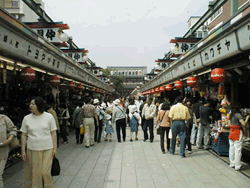 Stretching about 300 meters from Kaminarimon to Hozomon, Nakamise-dori is a shopping lane lined with 87 stalls (some say there are over 100) selling a variety of merchandise ranging from souvenirs to items for professional dancers and performers. Stretching about 300 meters from Kaminarimon to Hozomon, Nakamise-dori is a shopping lane lined with 87 stalls (some say there are over 100) selling a variety of merchandise ranging from souvenirs to items for professional dancers and performers.
Nakamise-dori dates back to the early Edo Period, when residents entrusted by Senso-ji to keep its precinct clean were granted special permission to put up souvenir stalls there.
The name Nakamise (middle market) comes from its location, which is between the broad street outside Kaminarimon gate and the stalls just outside Niomon gate (currently, Hozomon).
Though they were deprived of the privilege when Namamise-dori was placed under the control of the government of Tokyo, they were the first to gain the right to trade when Nakamise was later renovated into brick-buildings.
Nakamise stalls were burnt down in the Great Kanto Earthquake in 1925, and partially destroyed in WWII air raids in 1945. But it was restored after the war and has remained a must-see spot in downtown Asakusa.
|
| Sumida Park |
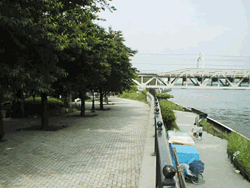 A place for recreation and relaxation for the locals, the Sumida River has been depicted in a number of performances and ukiyoe prints.
Cherry trees lining this scenic river are reminiscent of the Sumida River of olden times, while a Yamano yado no Watashiato (Yamano yado ferry pier ruins) stone monument evokes images of the Edo Period. A place for recreation and relaxation for the locals, the Sumida River has been depicted in a number of performances and ukiyoe prints.
Cherry trees lining this scenic river are reminiscent of the Sumida River of olden times, while a Yamano yado no Watashiato (Yamano yado ferry pier ruins) stone monument evokes images of the Edo Period.
Lining the river once known as Okawa (big river) is an embankment called the Super Teibou combined with a waterside park. During summer, people flock to the river to enjoy the cool evening breeze and watch yakatabune (covered sightseeing boats) pass by. The fireworks show in July, originally held to mark the opening of the river to the public each summer, has become a major seasonal event in Tokyo and is even broadcast live on TV.
|
| Tokyo Metro Ginza Line |
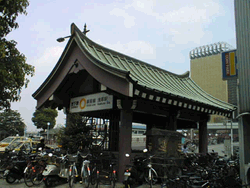 As Japan’s first subway line, Tokyo Metro Ginza Line has been a symbol of the development of modern Tokyo. As Japan’s first subway line, Tokyo Metro Ginza Line has been a symbol of the development of modern Tokyo.
On the walls of both the Asakusa and Tawara-machi stations, you will find the family crests of famous kabuki and other actors.
|
| Bentendo Kanetsukido |
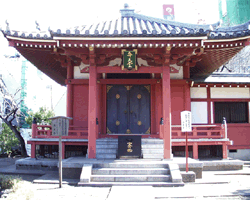 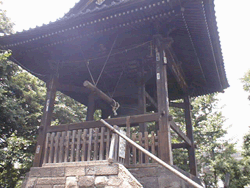 Bentendo, one of the three major Benten temples in Kanto, has a campanile (Kanetsukido) which was constructed in 1692 and was used to announce the hours to the people of Edo. It is said that one of the monks who rang the bell used to earn money by collecting a “bell toll” from residents in the vicinity. Bentendo, one of the three major Benten temples in Kanto, has a campanile (Kanetsukido) which was constructed in 1692 and was used to announce the hours to the people of Edo. It is said that one of the monks who rang the bell used to earn money by collecting a “bell toll” from residents in the vicinity.
At this popular destination for New Year worshippers, the congregations sound the bell on the New Year’s Eve to mark the first visit to the shrine in the New Year. The scene of geishas sounding the bell adds to the Asakusa flavor. This temple is also known as a place from which NHK broadcast its first “Yukutoshi Kurutoshi” (ringing out the old year and ringing in the new) program. Also, it was depicted in Basho Matsuo’s poem, Okunohosomichi ? “Hana no Kumo, Kane wa Ueno ka, Asakusa ka.” (A cloud of flowers! Is that the bell from Ueno or Asakusa?)
|
| Denpoin-dori |
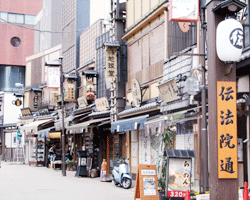 This is an Asakusa street from the good old days ? lined with stalls and little changed since the end of WWII. You will find low-priced clothes with distinctive designs. This is an Asakusa street from the good old days ? lined with stalls and little changed since the end of WWII. You will find low-priced clothes with distinctive designs.
|
| Denpoin Temple |
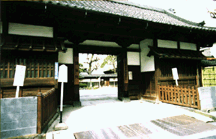 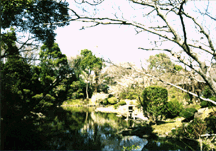 Established in 1777, Denpoin is the parent temple of Senso-ji and is also a place for monks to perform the ascetic practices. It has in its precincts a garden and a Shinji-ike (pond shaped like the Chinese character for kokoro, or heart) designed by Shusaku Kobori about 340 years ago. Though they are generally not open to the public, you might get to take a look inside for free if you are lucky. Established in 1777, Denpoin is the parent temple of Senso-ji and is also a place for monks to perform the ascetic practices. It has in its precincts a garden and a Shinji-ike (pond shaped like the Chinese character for kokoro, or heart) designed by Shusaku Kobori about 340 years ago. Though they are generally not open to the public, you might get to take a look inside for free if you are lucky.
|
| Chingodo |
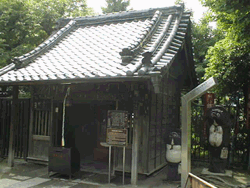 The Chingodo shrine has been in place since 1872. According to an article that was published in Japan’s first daily news paper, The Tokyo Nichinichi Shimbun on April 10th of that year, the shrine was built to stop the escapades of raccoon dogs which had started to bewitch the people of Asakusa by day and night after they had come to the area from the mountains in Ueno but were able to find a place to settle. On the right side just past the gate, you will find a mound known as Hoken-zuka, which was built by a Hoken-san, or male geisha, whose job it was to attend and warm up the parties of geishas and guests held in the Yoshiwara red-light district. The Hokan-san is often depicted as a Taiko-mochi (drum bearer) in rakugo. You also can reach the Denpoin garden from here. The Chingodo shrine has been in place since 1872. According to an article that was published in Japan’s first daily news paper, The Tokyo Nichinichi Shimbun on April 10th of that year, the shrine was built to stop the escapades of raccoon dogs which had started to bewitch the people of Asakusa by day and night after they had come to the area from the mountains in Ueno but were able to find a place to settle. On the right side just past the gate, you will find a mound known as Hoken-zuka, which was built by a Hoken-san, or male geisha, whose job it was to attend and warm up the parties of geishas and guests held in the Yoshiwara red-light district. The Hokan-san is often depicted as a Taiko-mochi (drum bearer) in rakugo. You also can reach the Denpoin garden from here.
|
| Nisonbutsu |
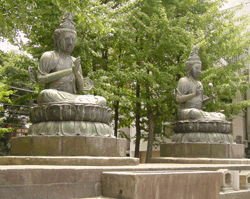 Situated within the precincts of Senso-ji and also known as “nure-botoke” (open-air statue of Buddha), this pair of 2.36 meter-high seated Buddha statues consist of a kannon statue on the right and a seishi-bosatsu statue on the left. They were built in August of 1687 by Yoshibei Takase (Okubo Village in Tatebayashi, Ueno ? currently Gunma Prefecture) in memory of and out of gratitude to Yoshizaburo Narii, a rice wholesaler in Ise-cho, NIhonbashi that Yoshibei had worked for, and to pray for business success for his son Jirosuke. The kannon statue is dedicated to Yoshizaburo and the seishi-bosatsu statue to Jirosuke. Engraving on the statues indicates that they were repaired in March of 1777. Situated within the precincts of Senso-ji and also known as “nure-botoke” (open-air statue of Buddha), this pair of 2.36 meter-high seated Buddha statues consist of a kannon statue on the right and a seishi-bosatsu statue on the left. They were built in August of 1687 by Yoshibei Takase (Okubo Village in Tatebayashi, Ueno ? currently Gunma Prefecture) in memory of and out of gratitude to Yoshizaburo Narii, a rice wholesaler in Ise-cho, NIhonbashi that Yoshibei had worked for, and to pray for business success for his son Jirosuke. The kannon statue is dedicated to Yoshizaburo and the seishi-bosatsu statue to Jirosuke. Engraving on the statues indicates that they were repaired in March of 1777.
|
| Imado Shrine |
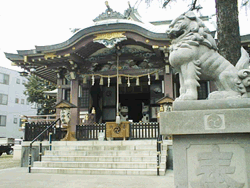 The history of this shrine goes back to 1063 AD when, under imperial orders, shogun Minamoto Yoritomo offered prayers at the Tsurugaoka-Hachiman Shrine in Kamakura, the Iwashimizu-Hachiman Shrine in Kyoto and the Imanotsu Shrine (currently Imado) in Asakusa. Imado shrine is dedicated to Fukurokuju, another of the Seven Gods of Good Luck. After it was burnt down in disasters and rebuilt on numerous occasions, the present solemn building was built with money offered by worshippers. The god of this shrine has long been believed to be the god of marriage and a solid production base. Since it is also known as the birthplace of the maneki-neko (beckoning cat), many young women visit this shrine to write their wishes on cute votive maneki-neko tablets, believing that the maneki neko will help them come true. The history of this shrine goes back to 1063 AD when, under imperial orders, shogun Minamoto Yoritomo offered prayers at the Tsurugaoka-Hachiman Shrine in Kamakura, the Iwashimizu-Hachiman Shrine in Kyoto and the Imanotsu Shrine (currently Imado) in Asakusa. Imado shrine is dedicated to Fukurokuju, another of the Seven Gods of Good Luck. After it was burnt down in disasters and rebuilt on numerous occasions, the present solemn building was built with money offered by worshippers. The god of this shrine has long been believed to be the god of marriage and a solid production base. Since it is also known as the birthplace of the maneki-neko (beckoning cat), many young women visit this shrine to write their wishes on cute votive maneki-neko tablets, believing that the maneki neko will help them come true.
|
| Tanuki-dori |
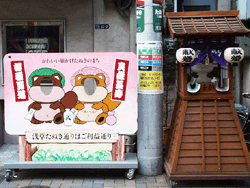 The name of this street comes from the fact that there were many raccoon dogs, the playful tricksters of old Japan, throughout Asakusa until the Meiji Period. Legend has it that those creatures regretted all the tricks they had played on people and realized the value of helping them out instead. Later, twelve of them trained to become gankake-tanuki (wish-granting raccoon dogs), which the locals began to worship. On the third Sunday of each month, complimentary food and drink, and fun events are offered to shoppers in commemoration of the gankake-tanukis now housed in decorated small shrines. You can buy goods depicting a humorous tanuki couple (charms, etc.) at a shop called HOTEIYA. You might even be able to secure divine grace by dropping a few coins into the offertory box at the raccoon couple shrine! “Goriyaku-ken” (fortune tickets) attached to the pamphlets available at the raccoon shrines might also bring you luck. This is an attractive street with a homey atmosphere. The name of this street comes from the fact that there were many raccoon dogs, the playful tricksters of old Japan, throughout Asakusa until the Meiji Period. Legend has it that those creatures regretted all the tricks they had played on people and realized the value of helping them out instead. Later, twelve of them trained to become gankake-tanuki (wish-granting raccoon dogs), which the locals began to worship. On the third Sunday of each month, complimentary food and drink, and fun events are offered to shoppers in commemoration of the gankake-tanukis now housed in decorated small shrines. You can buy goods depicting a humorous tanuki couple (charms, etc.) at a shop called HOTEIYA. You might even be able to secure divine grace by dropping a few coins into the offertory box at the raccoon couple shrine! “Goriyaku-ken” (fortune tickets) attached to the pamphlets available at the raccoon shrines might also bring you luck. This is an attractive street with a homey atmosphere.
|
| Stage EN |
 The main theater and rehearsal studio for the theater company EN, where famous Japanese TV actors/actresses practice and perform everyday. In this small theater with only 98 seats, EN performs a variety of pieces, ranging from classical pieces, stories written by popular playwrights and performances for children, overwhelming the audience with their presence and an atmosphere which larger theaters cannot offer. The main theater and rehearsal studio for the theater company EN, where famous Japanese TV actors/actresses practice and perform everyday. In this small theater with only 98 seats, EN performs a variety of pieces, ranging from classical pieces, stories written by popular playwrights and performances for children, overwhelming the audience with their presence and an atmosphere which larger theaters cannot offer.
http://www.en21.co.jp
|
| Outlet store for Toy and Hobby Goods |
Brotherhood |
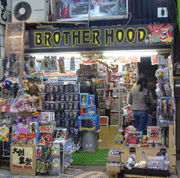
|
1-1-10 Asakusa
03-3845-5417
Open 10:00am-10:00pm
Open 365 days a year |
|
This outlet store was opened in November of 1999 by a toy wholesaler with a history that stretches back to the Taisho period.
Here, items still found on retail store shelves or even collectibles are available at discount prices.
Sorry for toy lovers out there who have already purchased them at full price! |
|
| Musical Instruments |
Japan Percussion Center |
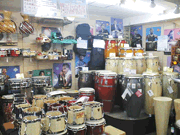
|
Komaki Bldg. 4-6F, 1-7-1 Nishi-Asakusa
03-3845-3041
Open 11:00am-8:00pm
Open 365 days a year |
|
A percussion instrument store located on Asakusa Kokusai-dori, also known as Beat Street, consists of the 3 floors; Drum City (4F) for drums, Ethnic City (5F) for folk percussion instruments and Percussion City (6F) for concert percussion instruments. Of special interest is Ethnic City, where you will find all types of exotic drums including Djembe, an African drum that is currently enjoying popularity throughout the world. This is a fun floor for everyone.
Link to HP |
|





 Known to the locals as Sanja-sama, Asakusa Shrine is located on the east side of Senso-ji Temple’s main building and is dedicated to Ebisu, one of the Seven Gods of Good Luck. The Asakusa Shrine festival, the Sanja Matsuri, is one of three major festivals that take place in Asakusa. Enshrined here are three men ? the Hinokuma Brothers and Hajino Nakatomo, from which the name Sanja(three gods)originated. A crest on the wall of a building where portable shrines are stored depicts three nets being cast, signifying that the chief priests of this shrine have been the descendents of the HInokuma Brothers. Built in 1649 by Tokugawa Iemitsu, the third shogun of the Tokugawa era, it has survived a number of fires over its 360-year history. It is designated a National Important Cultural Property by the Japanese government, and its gongen-style architecture takes you back to old Edo. You will also find Aoino-gomon, the Tokugawa crest, on the shrine. Many people visit Asakusa Shrine to see the kappore dance(a popular dance from the Edo Period) and monkey shows that are put on for their enjoyment. Visitors who come on holidays during the spring and fall are also welcome to enjoy a special cup of tea prepared in a traditional tea ceremony and served by geisha. Traditional Shinto-style wedding ceremonies held in the solemn atmosphere of this cultural heritage have become increasingly popular of late. The sight of beautiful kimono-clad brides in rickshaws en route to Asakusa Shrine is another part of Asakusa’s charm.
Known to the locals as Sanja-sama, Asakusa Shrine is located on the east side of Senso-ji Temple’s main building and is dedicated to Ebisu, one of the Seven Gods of Good Luck. The Asakusa Shrine festival, the Sanja Matsuri, is one of three major festivals that take place in Asakusa. Enshrined here are three men ? the Hinokuma Brothers and Hajino Nakatomo, from which the name Sanja(three gods)originated. A crest on the wall of a building where portable shrines are stored depicts three nets being cast, signifying that the chief priests of this shrine have been the descendents of the HInokuma Brothers. Built in 1649 by Tokugawa Iemitsu, the third shogun of the Tokugawa era, it has survived a number of fires over its 360-year history. It is designated a National Important Cultural Property by the Japanese government, and its gongen-style architecture takes you back to old Edo. You will also find Aoino-gomon, the Tokugawa crest, on the shrine. Many people visit Asakusa Shrine to see the kappore dance(a popular dance from the Edo Period) and monkey shows that are put on for their enjoyment. Visitors who come on holidays during the spring and fall are also welcome to enjoy a special cup of tea prepared in a traditional tea ceremony and served by geisha. Traditional Shinto-style wedding ceremonies held in the solemn atmosphere of this cultural heritage have become increasingly popular of late. The sight of beautiful kimono-clad brides in rickshaws en route to Asakusa Shrine is another part of Asakusa’s charm.  Senso-ji is the oldest temple in Tokyo and the seat of the Seikannon Sect, which carries the official name of Kinryuzan. Senso-ji is dedicated to Daikokuten, another of the Seven Gods of Good Luck. According to a legend, the history of this temple goes back 1,400 years to March 18, 628 AD, when two fishermen, the Hinokuma Brothers, found a statue of Buddha asuring about 5.5 cm in their fishing net as they pulled it out of the Etoura(now Sumida)River, and Hajino Nakatomo, the chief of their village, built a humble hut to enshrine the statue, became a priest and began worshipping the statue together with the two brothers who had found it. A kannon-do was built in its present location in the Heian Period by Kassai-Shonin, who opened it in the first year of Taika(645 AD). Since that time to this very day, the statue has not once been shown to the public. This temple is said to be the place where Tokugawa Ieyasu offered prayers before departing for the battle of Sekigahara to win control of the entire country. In 1649, after it was designated the official prayer hall of Tokugawa Ieyasu(deitified and named Tosho-Daigongen after his death), the third Tokugawa shogun, Iemitsu, had the temple building built. Later, following the relocation of the prayer hall to Ueno Kanei-ji Temple, it was cherished as a major religious site by the commoners.
Senso-ji is the oldest temple in Tokyo and the seat of the Seikannon Sect, which carries the official name of Kinryuzan. Senso-ji is dedicated to Daikokuten, another of the Seven Gods of Good Luck. According to a legend, the history of this temple goes back 1,400 years to March 18, 628 AD, when two fishermen, the Hinokuma Brothers, found a statue of Buddha asuring about 5.5 cm in their fishing net as they pulled it out of the Etoura(now Sumida)River, and Hajino Nakatomo, the chief of their village, built a humble hut to enshrine the statue, became a priest and began worshipping the statue together with the two brothers who had found it. A kannon-do was built in its present location in the Heian Period by Kassai-Shonin, who opened it in the first year of Taika(645 AD). Since that time to this very day, the statue has not once been shown to the public. This temple is said to be the place where Tokugawa Ieyasu offered prayers before departing for the battle of Sekigahara to win control of the entire country. In 1649, after it was designated the official prayer hall of Tokugawa Ieyasu(deitified and named Tosho-Daigongen after his death), the third Tokugawa shogun, Iemitsu, had the temple building built. Later, following the relocation of the prayer hall to Ueno Kanei-ji Temple, it was cherished as a major religious site by the commoners.  Situated in front of Senso-ji Temple, the Kaminarimon gate, officially known as the Fu-raijin-mon, has a huge 3.4-meter wide paper lantern weighing 670 kg that hangs from it.
Situated in front of Senso-ji Temple, the Kaminarimon gate, officially known as the Fu-raijin-mon, has a huge 3.4-meter wide paper lantern weighing 670 kg that hangs from it. Built in 1618, Nitenmon has survived several wars. Its gate and stone bridge are designated as Important Cultural Properties. Originally used as the gate leading to Toshogu, where Tokugawa Ieyasu was enshrined, it was burnt down in a fire and later rebuilt in the present location.
Built in 1618, Nitenmon has survived several wars. Its gate and stone bridge are designated as Important Cultural Properties. Originally used as the gate leading to Toshogu, where Tokugawa Ieyasu was enshrined, it was burnt down in a fire and later rebuilt in the present location. A paddy field that the priests at Senso-ji had put in to prevent fire from reaching the temple was drained in 1883 and turned into an entertainment district. A pond created during the redemption work was named Hyotan-ike because its shape resembled a hyotan, or gourd (although there had already been two ponds with this name long before this, one near Hanayashiki amusement park and the other near the Sumida River).
A paddy field that the priests at Senso-ji had put in to prevent fire from reaching the temple was drained in 1883 and turned into an entertainment district. A pond created during the redemption work was named Hyotan-ike because its shape resembled a hyotan, or gourd (although there had already been two ponds with this name long before this, one near Hanayashiki amusement park and the other near the Sumida River). Matsuchiyama is a small hill on the west side of the Sumida River to the south of Imado-bashi Bridge. With the official name of Honryuin, Matsuchiyama-Shoten is a sub temple of Senso-ji, known as Shoten-sama by the locals.
Matsuchiyama is a small hill on the west side of the Sumida River to the south of Imado-bashi Bridge. With the official name of Honryuin, Matsuchiyama-Shoten is a sub temple of Senso-ji, known as Shoten-sama by the locals. The Asakusa Entertainment Hall is a playhouse that was known as the Toyo Gekijo (theater) until was reopened in 1964 under the current name. It has given many entertainers the chance to cut their teeth on its stage.
The Asakusa Entertainment Hall is a playhouse that was known as the Toyo Gekijo (theater) until was reopened in 1964 under the current name. It has given many entertainers the chance to cut their teeth on its stage. Formerly known as the Asakusa Fransu-za, it was located on the fourth floor of the Asakusa Entertainment Hall and is a place where many stars, such as world famous filmmaker Takeshi Kitano, a.k.a. Beat Takeshi, performed before they reached stardom.
Formerly known as the Asakusa Fransu-za, it was located on the fourth floor of the Asakusa Entertainment Hall and is a place where many stars, such as world famous filmmaker Takeshi Kitano, a.k.a. Beat Takeshi, performed before they reached stardom. Since its completion in 1989,the Asahi Head Office Building has become known as a symbol of Asakusa. Although the building itself is not open to the public, it has some nice restaurants on the 21st and 22nd floors that offer a splendid view of the Sumida River.
Since its completion in 1989,the Asahi Head Office Building has become known as a symbol of Asakusa. Although the building itself is not open to the public, it has some nice restaurants on the 21st and 22nd floors that offer a splendid view of the Sumida River. Built in the fall of 1977 with seating for 1,100, this auditorium offers a wide variety of shows and events. From the third floor, you can enjoy a view of the garden at Denpoin. On the stage equipped with a Hanamichi, a runway extending from the stage, Hanagata-kabuki (all-star kabuki) shows are performed. In the Stars Plaza, you can see the handprints of over 260 famous performers - Just like Hollywood, eh?
Built in the fall of 1977 with seating for 1,100, this auditorium offers a wide variety of shows and events. From the third floor, you can enjoy a view of the garden at Denpoin. On the stage equipped with a Hanamichi, a runway extending from the stage, Hanagata-kabuki (all-star kabuki) shows are performed. In the Stars Plaza, you can see the handprints of over 260 famous performers - Just like Hollywood, eh? Open since 1928, this entertainment hall used to have an amusement space with a merry-go-round and other attractions on the first floor, and a stage offering magic and rokyoku (storytelling) shows on the second floor.
Open since 1928, this entertainment hall used to have an amusement space with a merry-go-round and other attractions on the first floor, and a stage offering magic and rokyoku (storytelling) shows on the second floor. Stretching about 300 meters from Kaminarimon to Hozomon, Nakamise-dori is a shopping lane lined with 87 stalls (some say there are over 100) selling a variety of merchandise ranging from souvenirs to items for professional dancers and performers.
Stretching about 300 meters from Kaminarimon to Hozomon, Nakamise-dori is a shopping lane lined with 87 stalls (some say there are over 100) selling a variety of merchandise ranging from souvenirs to items for professional dancers and performers. A place for recreation and relaxation for the locals, the Sumida River has been depicted in a number of performances and ukiyoe prints.
Cherry trees lining this scenic river are reminiscent of the Sumida River of olden times, while a Yamano yado no Watashiato (Yamano yado ferry pier ruins) stone monument evokes images of the Edo Period.
A place for recreation and relaxation for the locals, the Sumida River has been depicted in a number of performances and ukiyoe prints.
Cherry trees lining this scenic river are reminiscent of the Sumida River of olden times, while a Yamano yado no Watashiato (Yamano yado ferry pier ruins) stone monument evokes images of the Edo Period. As Japan’s first subway line, Tokyo Metro Ginza Line has been a symbol of the development of modern Tokyo.
As Japan’s first subway line, Tokyo Metro Ginza Line has been a symbol of the development of modern Tokyo.
 Bentendo, one of the three major Benten temples in Kanto, has a campanile (Kanetsukido) which was constructed in 1692 and was used to announce the hours to the people of Edo. It is said that one of the monks who rang the bell used to earn money by collecting a “bell toll” from residents in the vicinity.
Bentendo, one of the three major Benten temples in Kanto, has a campanile (Kanetsukido) which was constructed in 1692 and was used to announce the hours to the people of Edo. It is said that one of the monks who rang the bell used to earn money by collecting a “bell toll” from residents in the vicinity. This is an Asakusa street from the good old days ? lined with stalls and little changed since the end of WWII. You will find low-priced clothes with distinctive designs.
This is an Asakusa street from the good old days ? lined with stalls and little changed since the end of WWII. You will find low-priced clothes with distinctive designs.
 Established in 1777, Denpoin is the parent temple of Senso-ji and is also a place for monks to perform the ascetic practices. It has in its precincts a garden and a Shinji-ike (pond shaped like the Chinese character for kokoro, or heart) designed by Shusaku Kobori about 340 years ago. Though they are generally not open to the public, you might get to take a look inside for free if you are lucky.
Established in 1777, Denpoin is the parent temple of Senso-ji and is also a place for monks to perform the ascetic practices. It has in its precincts a garden and a Shinji-ike (pond shaped like the Chinese character for kokoro, or heart) designed by Shusaku Kobori about 340 years ago. Though they are generally not open to the public, you might get to take a look inside for free if you are lucky. The Chingodo shrine has been in place since 1872. According to an article that was published in Japan’s first daily news paper, The Tokyo Nichinichi Shimbun on April 10th of that year, the shrine was built to stop the escapades of raccoon dogs which had started to bewitch the people of Asakusa by day and night after they had come to the area from the mountains in Ueno but were able to find a place to settle. On the right side just past the gate, you will find a mound known as Hoken-zuka, which was built by a Hoken-san, or male geisha, whose job it was to attend and warm up the parties of geishas and guests held in the Yoshiwara red-light district. The Hokan-san is often depicted as a Taiko-mochi (drum bearer) in rakugo. You also can reach the Denpoin garden from here.
The Chingodo shrine has been in place since 1872. According to an article that was published in Japan’s first daily news paper, The Tokyo Nichinichi Shimbun on April 10th of that year, the shrine was built to stop the escapades of raccoon dogs which had started to bewitch the people of Asakusa by day and night after they had come to the area from the mountains in Ueno but were able to find a place to settle. On the right side just past the gate, you will find a mound known as Hoken-zuka, which was built by a Hoken-san, or male geisha, whose job it was to attend and warm up the parties of geishas and guests held in the Yoshiwara red-light district. The Hokan-san is often depicted as a Taiko-mochi (drum bearer) in rakugo. You also can reach the Denpoin garden from here. Situated within the precincts of Senso-ji and also known as “nure-botoke” (open-air statue of Buddha), this pair of 2.36 meter-high seated Buddha statues consist of a kannon statue on the right and a seishi-bosatsu statue on the left. They were built in August of 1687 by Yoshibei Takase (Okubo Village in Tatebayashi, Ueno ? currently Gunma Prefecture) in memory of and out of gratitude to Yoshizaburo Narii, a rice wholesaler in Ise-cho, NIhonbashi that Yoshibei had worked for, and to pray for business success for his son Jirosuke. The kannon statue is dedicated to Yoshizaburo and the seishi-bosatsu statue to Jirosuke. Engraving on the statues indicates that they were repaired in March of 1777.
Situated within the precincts of Senso-ji and also known as “nure-botoke” (open-air statue of Buddha), this pair of 2.36 meter-high seated Buddha statues consist of a kannon statue on the right and a seishi-bosatsu statue on the left. They were built in August of 1687 by Yoshibei Takase (Okubo Village in Tatebayashi, Ueno ? currently Gunma Prefecture) in memory of and out of gratitude to Yoshizaburo Narii, a rice wholesaler in Ise-cho, NIhonbashi that Yoshibei had worked for, and to pray for business success for his son Jirosuke. The kannon statue is dedicated to Yoshizaburo and the seishi-bosatsu statue to Jirosuke. Engraving on the statues indicates that they were repaired in March of 1777. The history of this shrine goes back to 1063 AD when, under imperial orders, shogun Minamoto Yoritomo offered prayers at the Tsurugaoka-Hachiman Shrine in Kamakura, the Iwashimizu-Hachiman Shrine in Kyoto and the Imanotsu Shrine (currently Imado) in Asakusa. Imado shrine is dedicated to Fukurokuju, another of the Seven Gods of Good Luck. After it was burnt down in disasters and rebuilt on numerous occasions, the present solemn building was built with money offered by worshippers. The god of this shrine has long been believed to be the god of marriage and a solid production base. Since it is also known as the birthplace of the maneki-neko (beckoning cat), many young women visit this shrine to write their wishes on cute votive maneki-neko tablets, believing that the maneki neko will help them come true.
The history of this shrine goes back to 1063 AD when, under imperial orders, shogun Minamoto Yoritomo offered prayers at the Tsurugaoka-Hachiman Shrine in Kamakura, the Iwashimizu-Hachiman Shrine in Kyoto and the Imanotsu Shrine (currently Imado) in Asakusa. Imado shrine is dedicated to Fukurokuju, another of the Seven Gods of Good Luck. After it was burnt down in disasters and rebuilt on numerous occasions, the present solemn building was built with money offered by worshippers. The god of this shrine has long been believed to be the god of marriage and a solid production base. Since it is also known as the birthplace of the maneki-neko (beckoning cat), many young women visit this shrine to write their wishes on cute votive maneki-neko tablets, believing that the maneki neko will help them come true. The name of this street comes from the fact that there were many raccoon dogs, the playful tricksters of old Japan, throughout Asakusa until the Meiji Period. Legend has it that those creatures regretted all the tricks they had played on people and realized the value of helping them out instead. Later, twelve of them trained to become gankake-tanuki (wish-granting raccoon dogs), which the locals began to worship. On the third Sunday of each month, complimentary food and drink, and fun events are offered to shoppers in commemoration of the gankake-tanukis now housed in decorated small shrines. You can buy goods depicting a humorous tanuki couple (charms, etc.) at a shop called HOTEIYA. You might even be able to secure divine grace by dropping a few coins into the offertory box at the raccoon couple shrine! “Goriyaku-ken” (fortune tickets) attached to the pamphlets available at the raccoon shrines might also bring you luck. This is an attractive street with a homey atmosphere.
The name of this street comes from the fact that there were many raccoon dogs, the playful tricksters of old Japan, throughout Asakusa until the Meiji Period. Legend has it that those creatures regretted all the tricks they had played on people and realized the value of helping them out instead. Later, twelve of them trained to become gankake-tanuki (wish-granting raccoon dogs), which the locals began to worship. On the third Sunday of each month, complimentary food and drink, and fun events are offered to shoppers in commemoration of the gankake-tanukis now housed in decorated small shrines. You can buy goods depicting a humorous tanuki couple (charms, etc.) at a shop called HOTEIYA. You might even be able to secure divine grace by dropping a few coins into the offertory box at the raccoon couple shrine! “Goriyaku-ken” (fortune tickets) attached to the pamphlets available at the raccoon shrines might also bring you luck. This is an attractive street with a homey atmosphere. The main theater and rehearsal studio for the theater company EN, where famous Japanese TV actors/actresses practice and perform everyday. In this small theater with only 98 seats, EN performs a variety of pieces, ranging from classical pieces, stories written by popular playwrights and performances for children, overwhelming the audience with their presence and an atmosphere which larger theaters cannot offer.
The main theater and rehearsal studio for the theater company EN, where famous Japanese TV actors/actresses practice and perform everyday. In this small theater with only 98 seats, EN performs a variety of pieces, ranging from classical pieces, stories written by popular playwrights and performances for children, overwhelming the audience with their presence and an atmosphere which larger theaters cannot offer. 

